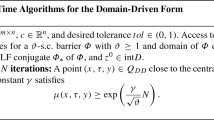Abstract
We evaluate the practical relevance of two measures of conic convex problem complexity as applied to second-order cone problems solved using the homogeneous self-dual (HSD) embedding model in the software SeDuMi. The first measure we evaluate is Renegar's data-based condition measure C(d), and the second measure is a combined measure of the optimal solution size and the initial infeasibility/optimality residuals denoted by S (where the solution size is measured in a norm that is naturally associated with the HSD model). We constructed a set of 144 second-order cone test problems with widely distributed values of C(d) and S and solved these problems using SeDuMi. For each problem instance in the test set, we also computed estimates of C(d) (using Peña’s method) and computed S directly. Our computational experience indicates that SeDuMi iteration counts and log (C(d)) are fairly highly correlated (sample correlation R = 0.675), whereas SeDuMi iteration counts are not quite as highly correlated with S (R = 0.600). Furthermore, the experimental evidence indicates that the average rate of convergence of SeDuMi iterations is affected by the condition number C(d) of the problem instance, a phenomenon that makes some intuitive sense yet is not directly implied by existing theory.
Similar content being viewed by others
References
R.M. Freund, “Complexity of convex optimization using geometry-based measures and a reference point,” Mathematical Programming, vol. 99, pp. 197–221, 2004.
R.M. Freund, “On the behavior of the homogeneous self-dual model for conic convex optimization,” to appear in Mathematical Programming.
R.M. Freund and J. Vera, “Some characterization and properties of the ‘distance to ill-posedness’ and the condition measure of a conic linear system,” Mathematical Programming, vol. 86, pp. 225–260, 1999.
R.M. Freund and J. Vera, “Condition-based complexity of convex optimization in conic linear form via the ellipsoid algorithm,” SIAM Journal on Optimization, vol. 10, pp. 155–176, 1999.
R.M. Freund and J. Vera, “On the complexity of computing estimates of condition measures of a conic linear system,” Mathematics of Operations Research, vol. 28, pp. 625–648, 2003.
Y. Nesterov and A. Nemirovskii, “Interior-Point Polynomial Algorithms in Convex Programming,” Society for Industrial and Applied Mathematics (SIAM), Philadelphia, 1994.
F. Ordóñez and R.M. Freund, “Computational experience and the explanatory value of condition measures for linear optimization,” SIAM Journal on Optimization, vol. 14, pp. 307–333, 2004.
J. Peña, “Computing the distance to infeasibility: Theoretical and practical issues,” Technical report, Center for Applied Mathematics, Cornell University, 1998.
J . Peña, “Understanding the geometry of infeasible perturbation of a conic linear system,” SIAM Journal on Optimization,vol. 10, pp. 534–550, 2000.
J. Peña, “Two properties of condition numbers for convex programs via implicitly defined barrier functions, Mathematical Programming,” vol. 93, pp. 55–57, 2002.
J. Renegar, “Some perturbation theory for linear programming, “Mathematical Programming,” vol. 65, pp. 73–91, 1994.
J. Renegar, “Linear programming, complexity theory, and elementary functional analysis,” Mathematical Programming, vol. 70, pp. 279–351, 1995.
J.F. Sturm, “Using SeDuMi 1.02, a Matlab toolbox for optimization over symmetric cones,” Optimization Methods and Software, vols. 11/12, pp. 625–653, 1999.
Y. Ye, M.J. Todd, and S. Mizuno, “On \(O(\sqrt{n}L)\)-iteration homogeneous and self-dual linear programming algorithm,” Mathematics of Operations Research, vol. 19, pp. 53–67, 1994.
Author information
Authors and Affiliations
Corresponding author
Additional information
This research has been partially supported through the MIT-Singapore Alliance.
Rights and permissions
About this article
Cite this article
Cai, Z., Freund, R.M. On Two Measures of Problem Instance Complexity and their Correlation with the Performance of SeDuMi on Second-Order Cone Problems. Comput Optim Applic 34, 299–319 (2006). https://doi.org/10.1007/s10589-005-3911-0
Received:
Revised:
Accepted:
Published:
Issue Date:
DOI: https://doi.org/10.1007/s10589-005-3911-0




